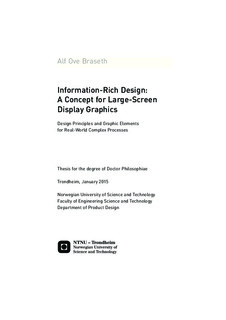| dc.contributor.author | Braseth, Alf Ove | |
| dc.date.accessioned | 2015-07-10T07:30:54Z | |
| dc.date.available | 2015-07-10T07:30:54Z | |
| dc.date.issued | 2015 | |
| dc.identifier.isbn | 978-82-326-0728-0 | |
| dc.identifier.isbn | 978-82-326-0729-7 | |
| dc.identifier.issn | 1503-8181 | |
| dc.identifier.uri | http://hdl.handle.net/11250/292990 | |
| dc.description.abstract | The objective in this thesis research is to mitigate two problems, which are typically experienced by
control room operators monitoring large-scale processes in centralized control rooms: i) How to
design for rapid perception of industrial-scale data sets? ii) How to avoid keyhole effects in
complex processes? In this thesis, these problems are approached through research into Large-
Screen Display (LSD) design; the contribution is a concept named Information-Rich Design (IRD).
The concept is not domain specific, and it is useable typically for nuclear and petroleum industries.
IRD can be used as a starting point for user-centred design, as opposed to approaching the
problem from the technology end first. The thesis research is based on a broad perspective,
through interaction design research methods: design exploration, design studies and design
practice.
Design exploration was done on a small-scale early in the research process, and later through
three complete LSD applications. The first two LSDs were implemented on full-scale nuclear
simulators, and the most recent was implemented for an operational nuclear research reactor.
Crews of certified control room operators have provided feedback for design in an iterative
research process. Design studies were based on findings from basic, applied and clinical research:
(1) human capabilities and characteristics, (2) principles for information visualization, (3) findings
from human-computer interaction and (4) research from other related display concepts. Design
practice from applying IRD commercially in Norwegian petroleum industry was fed back into the
concept.
The thesis research suggests that LSDs should be designed from the ground-up, acting as a stable
frame of reference for process monitoring, leaving details for desktop workstations. Research
found that larger displays should support bottom-up data driven processes by presenting process
data as simple visual patterns, suitable for rapid visual perception. Further, LSDs should support
operators in top-down search for information, and aim to avoid keyhole effects through externalized
graphics, which do not load limited visual memory resources. Graphics should reduce visual
complexity by creating visual hierarchies, giving critical information the most prominent visual
salience, while avoiding masking primary data from less important information. Based on this, the
contribution for LSD designs, are design principles and accompanying graphics.
The IRD concept is theoretically validated, and externally validated through industrial applications
and user tests. With a few concerns for inconsistency from using mathematical normalized scales
in graphics, and readability of the grey-layered colours, the concept is generally found to be a
reasonable approach on LSD design and the two research problems. The research contribution is
not radical or revolutionary; rather it extends what others have found for computer graphics for
smaller displays. It is positioned as applied research for LSD design, as a contribution to humancomputer
interaction. The innovative part of this thesis contribution is design-patented graphics for
information presentation.
Further work should focus on providing more quantitative performance data, and on performing
comparisons with other display concepts, particularly measuring Situation Awareness levels.
Secondly, one should look at the question of consistency with other displays in the same setting. A
natural extension of this thesis work would be to look at direct process interaction through LSDs. | nb_NO |
| dc.language.iso | eng | nb_NO |
| dc.publisher | NTNU | nb_NO |
| dc.relation.ispartofseries | Doctoral thesis at NTNU;2015:30 | |
| dc.relation.haspart | Paper 1:
Alf Ove Braseth, Robin Welch and Øystein Veland
A Building Block for Information Rich Displays
IFEA Conference 2003 | |
| dc.relation.haspart | Paper 2:
Braseth A.O., Veland Ø., Welch R. (2004). Information Rich Display Design, paper in Proceedings,
Forth American Nuclear Society International Topical Meeting on Nuclear Plant Instrumentation,
Controls and Human-Machine Interface Technologies NPIC&HMIT, | |
| dc.relation.haspart | Paper 3:
Braseth A.O., Nurmilaukas V., Laarni J. (2009). Realizing the Information Rich Design for the
Loviisa Nuclear Power Plant. Paper in Proceedings, Sixth American Nuclear Society International
Topical Meeting on Nuclear Plant Instrumentation, Control and Human-Machine Interface
Technologies NPIC&HMIT | |
| dc.relation.haspart | Paper 4:
J. Laarni, H. Koskinen, L. Salo, L. Norros, A.O. Braseth, V. Nurmilaukas (2009). Evaluation of the
Fortum IRD Pilot. Paper in Proceedings, Sixth American Nuclear Society International Topical
Meeting on Nuclear Plant Instrumentation, Control and Human-Machine Interface Technologies
NPIC&HMIT | |
| dc.relation.haspart | Paper 6:
Braseth, Alf Ove; Karlsson, Tommy; Jokstad, Håkon.
Improving alarm visualization and consistency for a BWR large screen display using the information rich concept. I: Proceedings of the 7th International Topical Meeting on Nuclear Plant Instrumentation, Control and Human-Machine Interface Technologies. American Nuclear Society 2010 | |
| dc.relation.haspart | Paper 7:
Braseth, Alf Ove; Øritsland, Trond Are.
Visualizing complex processes on large screen displays: Design principles based on the Information Rich Design concept. Displays (Guildford) 2013 ;Volum 34.(3) s. 215-222
<a href="http://dx.doi.org/10.1016/j.displa.2013.05.002" target="_blank"> http://dx.doi.org/10.1016/j.displa.2013.05.002</a>
This article is reprinted with kind permission from Elsevier, sciencedirect.com | |
| dc.relation.haspart | Paper 8:
Braseth, Alf Ove; Øritsland, Trond Are.
Seeing the Big Picture: Principles for dynamic process data visualization on Large Screen Displays. International conference on complexity, cybernetics and informing science and engineering | |
| dc.relation.haspart | Paper 9:
Braseth A.O. (2013). Evaluating usability of the Halden Reactor Large Screen Display: Is the
Information Rich Design concept suitable for real-world installations? International Journal of
Nuclear Safety and Simulation, Vol. 4, No. 2, pp. 160-169. | |
| dc.relation.haspart | Paper 10:
Braseth, Alf Ove.
Information-rich design for large-screen displays. Nuclear Engineering International 2014 ;Volum 59.(715) s. 22-24 | |
| dc.title | Information-Rich Design: A Concept for Large-Screen Display Graphics: Design Principles and Graphic Elements for Real-World Complex Processes | nb_NO |
| dc.type | Doctoral thesis | nb_NO |
| dc.subject.nsi | VDP::Technology: 500::Mechanical engineering: 570::Production and maintenance engineering: 572 | nb_NO |
